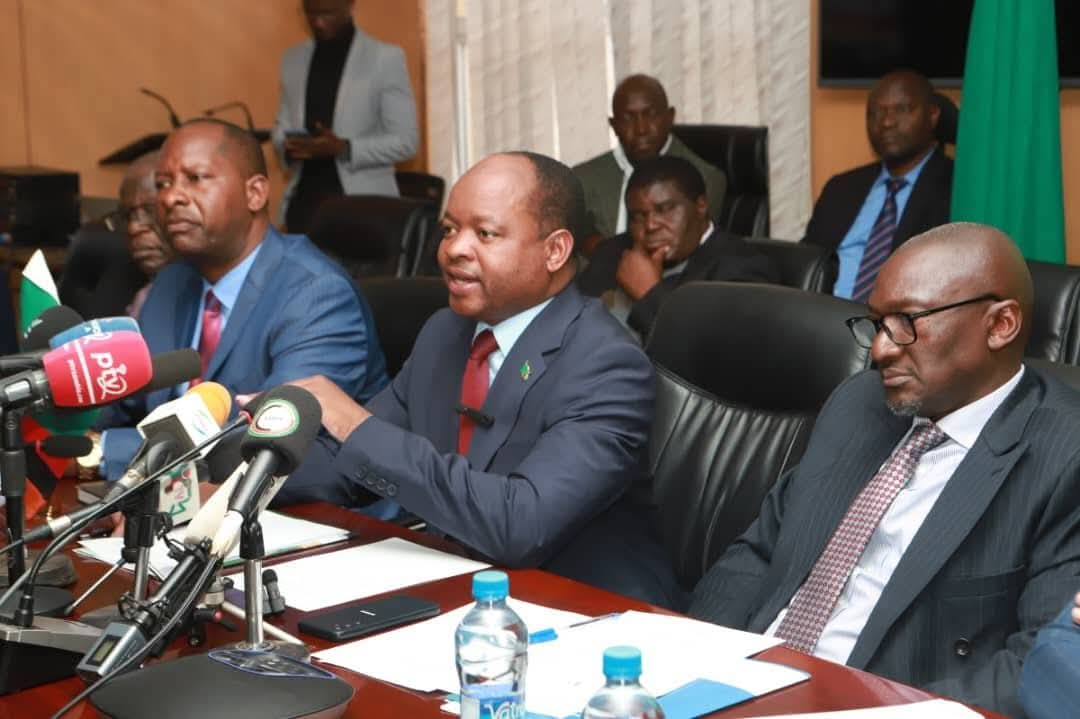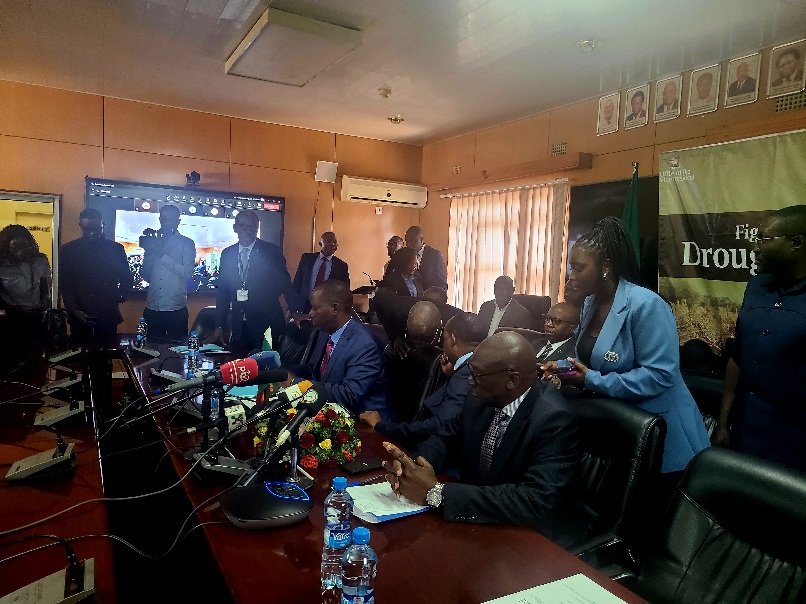Zambia Slams Alarmism,

... As Authorities Reassure Public, Declare Chambeshi River Pollution Contained
By Francis Maingaila
Lusaka, Zambia24 – (August 7, 2025) - The Zambian government has declared that the environmental pollution incident affecting the Chambeshi River and surrounding areas is under control, following months of coordinated and sustained response efforts.
Information and Media Minister Cornelius Mweetwa told journalists in Lusaka that there is no longer an immediate danger to human, animal, or plant life.
He emphasized that pH levels in the affected rivers have normalized, and concentrations of heavy metals have steadily declined since the incident occurred in February 2025.
“There is absolutely no need to press the panic button,” Mweetwa said. “The pH levels have returned to acceptable national and international standards, and the danger has been averted.”

The pollution incident stemmed from the failure of Tailings Dam 15F at Sentinel Resources Zambia Limited on February 18, resulting in the discharge of approximately 50,000 cubic meters of acidic tailings slurry into the Chambeshi Stream and further into the Mambashi, Lufubu, and Kafue Rivers.
The government, through the Zambia Environmental Management Agency (ZEMA), responded within 24 hours by suspending operations at the plant and conducting a physical inspection the following day.
On February 21, ZEMA issued an Environmental Restoration Order compelling the company to clean up the affected areas, assess environmental damage, and submit a detailed remediation plan.
The Ministry of Green Economy and Environment was directed to closely monitor water quality in the affected rivers.
Lime dosing was carried out to neutralize the acidic content, and by early March, pH levels had stabilized to a neutral reading of 7.
Additionally, over 200 water and sediment samples were collected for laboratory analysis. Of these, 37 results have been released, while 163 samples remain under review by independent laboratory Alfred H. Knight in Kitwe.
Initial findings from February indicated elevated concentrations of copper, cobalt, iron, manganese, zinc, and lead in some areas.
Mweetwa assured the public that remedial actions were implemented immediately and that testing and monitoring efforts continue.
He cautioned against the spread of alarmist reports based on preliminary or incomplete data, warning that such narratives could misinform the public and damage Zambia’s image abroad.
On the health front, the Ministry of Health deployed rapid response teams to Kitwe, Chingola, and other affected districts.
While three suspected cases of waterborne illness were reported in Kalulushi, all patients recovered fully.
No confirmed cases of acute heavy metal poisoning or pollution-related deaths have been recorded to date.
In response to the pollution, Nkana Water Supply and Sanitation Company shut down its Nkana East and Itawa treatment plants on February 28 after detecting abnormal pH readings.
The company activated emergency water supply using bowsers, and the treatment facilities were reopened on March 24 and 25 respectively after successful chemical treatment and restoration of acceptable water quality.
The Ministry of Mines and Minerals Development also took enforcement action, suspending all production at Sentinel and issuing a compliance order outlining 12 mandatory corrective actions.
The company was fined K1.5 million, which it has since paid. Furthermore, Sentinel has begun distributing interim compensation to affected communities for damaged crops and livelihoods.
The company is also preparing to decommission and rehabilitate the failed tailings dam.
Government has issued a broader directive to all mining and mineral processing companies to cease the disposal of acidic tailings into dams without prior neutralization.
Existing facilities must comply with this requirement by December 2025.
To ensure scientific accountability, government has invoked Section 107 of the Environmental Management Act and assumed full responsibility for conducting a comprehensive Environmental Impact Assessment (EIA), with all associated costs to be borne by the polluter.
A qualified consultant is being selected to carry out this independent assessment.
Mweetwa commended Sentinel Resources Zambia for its cooperation with government agencies and its willingness to comply with national environmental laws.
He also praised the coordinated efforts of various ministries and agencies, including ZEMA, the Ministry of Health, the Ministry of Green Economy and Environment, and local authorities, for their timely and effective response.
“We are grateful to the affected communities for their patience and cooperation during this difficult period. We understand your pain and assure you that the government will continue to provide the necessary support until the situation is fully resolved,” he said.
Mweetwa concluded by encouraging individuals or organizations with credible information to engage with the government directly and support its efforts to find a lasting solution.
He reiterated government’s commitment to holding polluters accountable, protecting public health, restoring affected areas, and promoting sustainable environmental development for future generations.
Mike Mposha – Minister of Green Economy and Environment
Responding to a question on whether the government has been reluctant to provide information about the pollution incident, Minister Mposha said:
"I do not believe it's accurate to say that the government has been reluctant. We have consistently shared the information we considered necessary at each stage. For instance, not long ago, I issued a detailed ministerial statement in Parliament outlining what actions the government had taken.
In early June, our ministry released a statement informing the nation that we had contracted an independent assessor under the provisions of Section 107 of the Environmental Management Act. This was done to ensure an objective assessment of the environmental impact.
Furthermore, two ministerial statements were issued earlier this year, one of which came from my colleague, the Minister of Water Development. These efforts were meant to inform the public about the measures the government was taking.
So, the suggestion that there was a lack of information is not accurate. We are here today, once again, to share updates with the public through the media.”
Collins Nzovu – Minister of Water Development and Sanitation
Minister Nzovu emphasized the government's efforts in ensuring the water was safe:
"Following the dam burst incident, immediate actions were taken to neutralize the affected water. We ensured that the pH levels were brought within acceptable limits, and regular testing has been ongoing since then.
Some of the key parameters we've been monitoring include manganese and zinc levels. Over the past few months, results from these tests have consistently fallen within World Health Organization (WHO) acceptable standards.
As the Chief Government Spokesperson already stated, more than 200 water samples were collected and analyzed. These tests were conducted before any water was supplied to communities. Government laboratories have been on standby and continue to enforce strict quality control measures.
We also engaged an independent consultant, Alfred Knight, to validate these findings. The results from Alfred Knight, the Zambia Environmental Management Agency (ZEMA), and the Ministry of Water Development are all aligned—showing that the water is within safe limits.
Therefore, concerns suggesting otherwise are unfounded. If other groups have conducted separate testing, we are open to engaging with them."
Cornelius Mweetwa – Minister of Information and Media
Minister Mweetwa addressed a question about why it took a foreign entity to inform the public about the situation:
"This concern has already been clarified. The truth is, the nation was first informed through Parliament via ministerial statements. Parliament serves as the platform for official government communication to the people, and members of Parliament are expected to disseminate that information to their constituencies.
Regarding the declaration of a national disaster, such a declaration is guided by law. Certain conditions must be met—primarily the scale and severity of the event, and whether the nation has the capacity to handle it without external assistance.
Declaring a national emergency signals to the international community that Zambia lacks the capacity to manage the crisis internally. This would justify redirecting national budget allocations and mobilizing resources beyond normal provisions.
On claims of geopolitical interference or 'Euro-politics', we want to be clear: the government responds strictly based on facts on the ground. When a situation arises, citizens and institutions may have access to different levels of information. However, only the government is mandated to collect, verify, and release official information.
Just as President Hakainde Hichilema recently ordered a forensic audit in a separate matter before making any public declarations, we in government follow due process. We do not release information prematurely or based on speculation.
We will always inform the nation at the appropriate time, based on verified findings—not because of external pressure."



Comments
Post a Comment